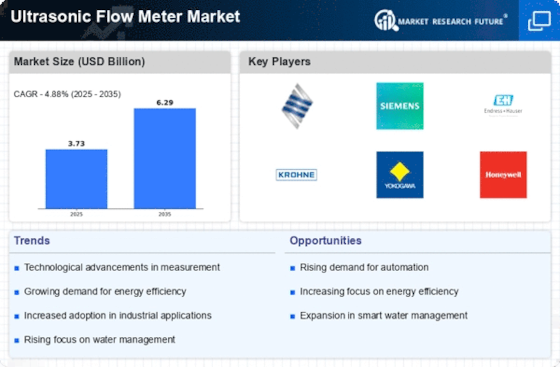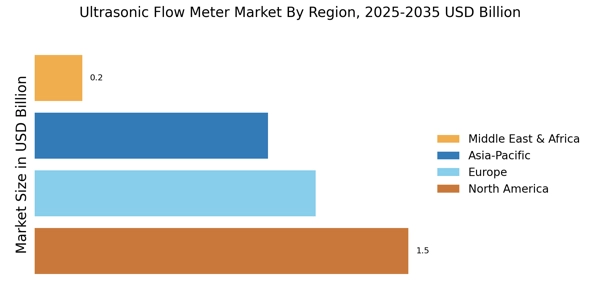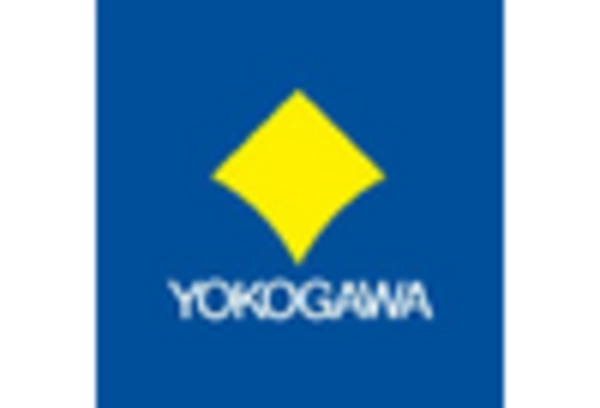Real-Time Monitoring
The demand for real-time monitoring solutions is significantly influencing the Ultrasonic Flow Meter Market. Industries are increasingly recognizing the value of continuous flow measurement for optimizing processes and enhancing operational efficiency. Ultrasonic flow meters provide real-time data that enables immediate decision-making, which is particularly beneficial in sectors such as chemical processing and water distribution. The ability to monitor flow rates in real-time allows for prompt detection of anomalies, reducing downtime and maintenance costs. This trend is expected to drive the Ultrasonic Flow Meter Market forward, as more companies seek to implement real-time monitoring systems to improve their operational capabilities.
Regulatory Compliance
Regulatory compliance is a critical driver for the Ultrasonic Flow Meter Market, as industries face increasing pressure to adhere to environmental and safety standards. Governments and regulatory bodies are implementing stringent guidelines regarding fluid measurement accuracy, particularly in sectors such as water treatment and energy production. Compliance with these regulations necessitates the adoption of advanced flow measurement technologies, including ultrasonic flow meters, which offer high precision and reliability. The market is witnessing a shift towards more sophisticated measurement solutions to meet these compliance requirements. As a result, the Ultrasonic Flow Meter Market is expected to see a steady increase in demand, as companies invest in technologies that ensure adherence to regulatory standards.
Growing Industrialization
The ongoing trend of industrialization is a substantial driver for the Ultrasonic Flow Meter Market. As countries continue to develop their industrial sectors, the demand for efficient fluid measurement solutions is rising. Industries such as manufacturing, oil and gas, and water treatment are increasingly adopting ultrasonic flow meters due to their accuracy and non-intrusive nature. The expansion of industrial activities is likely to create a robust market for ultrasonic flow meters, as companies seek to enhance their operational efficiency and reduce costs. This growth in industrialization is expected to contribute positively to the Ultrasonic Flow Meter Market, with projections indicating a steady increase in market size over the coming years.
Technological Advancements
The Ultrasonic Flow Meter Market is experiencing a surge in technological advancements that enhance measurement accuracy and efficiency. Innovations such as improved signal processing algorithms and advanced transducer designs are being integrated into new models. These developments not only increase the reliability of flow measurements but also expand the application range of ultrasonic flow meters across various sectors, including water management and oil and gas. The market is projected to grow at a compound annual growth rate (CAGR) of approximately 6% over the next few years, driven by these technological improvements. As industries seek to optimize their operations, the demand for sophisticated ultrasonic flow meters is likely to rise, further propelling the Ultrasonic Flow Meter Market.
Increased Focus on Energy Efficiency
The Ultrasonic Flow Meter Market is also being driven by an increased focus on energy efficiency across various sectors. Companies are actively seeking ways to reduce energy consumption and minimize waste, leading to a heightened demand for accurate flow measurement solutions. Ultrasonic flow meters play a crucial role in monitoring and optimizing fluid flow, which can significantly impact energy usage. As industries strive to implement more sustainable practices, the adoption of ultrasonic flow meters is likely to rise. This trend not only supports energy efficiency initiatives but also aligns with broader environmental goals, thereby fostering growth within the Ultrasonic Flow Meter Market.


















Leave a Comment